Oftentimes, the simplest method is the most effective method.
That’s one of the big reasons we usually suggest our hand portion method to clients who want to be aware of how much they’re eating to lose or gain weight, and/or to improve their health.
You might be wondering: If it’s so simple, why publish an FAQ?!
Well, even though our hand portion method has been validated through our experience with over 150,000 clients, no food tracking system is perfect.
Like any other method of food tracking, questions are bound to come up once you (or your clients) start using hand portions.
So to help you master the system, we’ve put together this “handy” guide.
It includes answers to all the most pressing hand-portion questions our coaches receive—plus some you (or your clients) might not have even thought of yet.
Use the links below to jump directly to the answers you’re looking for, or give the whole FAQ a read to learn how to troubleshoot the most common issues ahead of time. Question #1:
Question #1: “How do I explain hand portions to my clients?!”
Question #2: “How accurate are hand portions?”
Question #3: “How many hand portions should I eat?”
Question #4: “Can I do hand portions with Paleo, keto, plant-based eating, and other diets?”
Question #5: “Do I gauge my portions before or after cooking?”
Question #6: “How do I handle foods that don’t fit?”
Question #7: “How do I account for mixed-food meals?”
Question #8: “Are legumes and lentils protein or carbs?”
Question #9: “What do I do when I’m not seeing results with hand portions?”
Question #10: “How do I get skeptical clients on board with trying hand portions?”
Bonus Question: “Okay, but are there times when hand portions aren’t appropriate?”
++++
10 common hand-portion questions, answered
Question #1: “How do I explain hand portions to my clients?!”
Keep it short and sweet.
We’d suggest starting with something like:
You use your hand as a personalized, portable portioning tool.
You’re not actually measuring your food, but rather using your hand to gauge portion size. The following image sums it up nicely (and you can find a more detailed infographic here.)
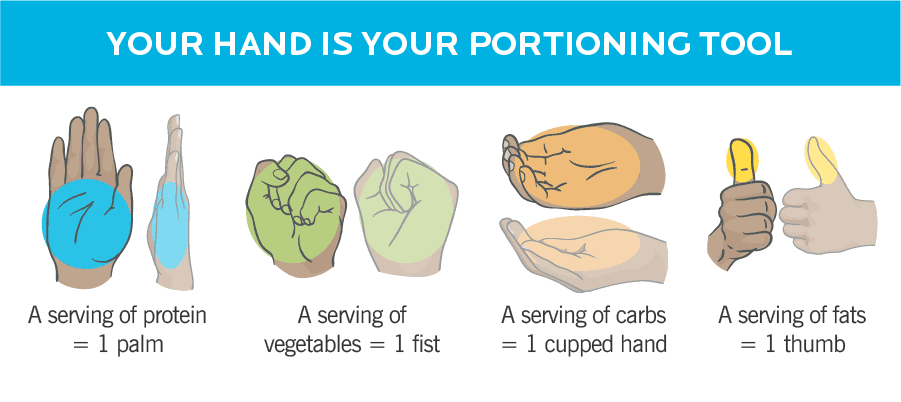
There are quite a few advantages to the system. Two we’d recommend mentioning right off the bat:
#1: Your hands are with you everywhere you go. This means you have a consistent reference point wherever you are—at the airport, your mom’s house, work lunches, buffet restaurants, and more. (It also means you don’t have to listen to your table mates groan as you furiously search for calorie counts in your food tracking app.)
#2: Your hands are generally proportional to your body and always the same size. So they serve as a reliable reference point—without the need for measuring cups or a food scale. (No need to wonder if your scale’s batteries are dying, or sheepishly pull your measuring cups out of your bag at your friend’s birthday dinner.)
From there, you can tackle a client’s specific questions or concerns as they come up.
Question #2: “How accurate are hand portions?”
Our internal calculations show hand portions are about 95 percent as accurate as carefully weighing, measuring, and tracking your food. With substantially less effort and time involved.
And since calorie databases—the tool most people use to track calories and macros—can be off by as much as 20 percent, the five percent difference here is negligible for most.1
Plus, as each hand portion correlates to a certain amount of protein, carbs, and/or fat, this method counts calories and macros for you.
It can help to see what that might look like in real-food terms, so the tables below provide perspective on what we consider general hand portion sizes.
| For Men | |
|---|---|
| 1 palm (protein) | ~4 oz (115 g) cooked meat / tofu, 1 cup Greek yogurt / cottage cheese, 1 scoop protein powder, 2 whole eggs |
| 1 fist (veggies) | ~1 cup non-starchy vegetables (spinach, carrots, cauliflower, peppers, etc.) |
| 1 cupped hand (carbs) | ~⅔ cup (130 g) cooked grains / legumes (rice, lentils, oats, etc.), 1 medium fruit, 1 medium tuber (potatoes, yams, etc.) |
| 1 thumb (fats) | ~1 tablespoon (14 g) oils, nuts, seeds, nut butters, cheese, dark chocolate, etc. |
| For Women | |
|---|---|
| 1 palm (protein) | ~3 oz (85 g) cooked meat / tofu, 1 cup Greek yogurt / cottage cheese, 1 scoop protein powder, 2 whole eggs |
| 1 fist (veggies) | ~1 cup non-starchy vegetables (spinach, carrots, cauliflower, peppers, etc.) |
| 1 cupped hand (carbs) | ~½ cup (100 g) cooked grains / legumes (rice, lentils, oats, etc.), 1 medium fruit, 1 medium tuber (potatoes, yams, etc.) |
| 1 thumb (fat) | ~1 tablespoon (14 g) oils, nuts, seeds, nut butters, cheese, dark chocolate, etc. |
Want to see the math? That’s totally fair, especially if you’re a numbers-oriented kind of person.
In the tables below, you can see what each portion is approximately equivalent to in grams of protein, carbohydrates, fat, and calories.
Note that the hand portion system assumes a mixed intake, meaning you’ll eat various food sources of each category. In other words, it assumes you’ll eat different protein sources like chicken, eggs, cottage cheese, and tofu for protein, as opposed to living on chicken breast.
Also, as you can see in the table below, most foods aren’t purely one macronutrient. That’s okay—the hand portion system accounts for that, too.
| Men’s portion macros | |
|---|---|
| 1 palm protein | ~ 24 g protein, 2 g carbs, 4.5 g fat, 145 kcal |
| 1 fist veggies | ~ 1.5 g protein, 5 g carbs, 0 g fat, 25 kcal |
| 1 cupped hand of carbs | ~ 3 g protein, 25 g carbs, 1 g fat, 120 kcal |
| 1 thumb fats | ~ 2 g protein, 2 g carbs, 9 g fat, 100 kcal |
| Women’s portion macros | |
|---|---|
| 1 palm protein | ~ 22 g protein, 2 g carbs, 4 g fat, 130 kcal |
| 1 fist veggies | ~ 1.5 g protein, 5 g carbs, 0 g fat, 25 kcal |
| 1 cupped hand of carbs | ~ 3 g protein, 22 g carbs, 1 g fat, 110 kcal |
| 1 thumb fats | ~ 2 g protein, 2 g carbs, 8 g fat, 90 kcal |
Testing the hand portion math
Let’s see how this system works in practice and in comparison to manually tracking macros and calories.
Example 1: High-level female athlete, 135 pounds with 18% body fat, who trains twice per day
- Pre-Workout @ 6am: 16 oz black coffee, 1 cup plain low-fat Greek yogurt, 1 cup chopped pineapple, 2 tbsp chopped walnuts, 1 glass of water
- Workout @ 7:15-8:30am: Sips on 16 oz water during training session
- Post-Workout Shake @ 9:00am: 12 oz water, 2 scoops protein powder, 1 medium apple, 1/2 cup old-fashioned oats, 2 cups of spinach, 1 tbsp ground flax seed, 1 tbsp almond butter
- Lunch @ 12pm: 3 oz salmon, 1 cup steamed mixed veggies, 1 medium sweet potato, 1 tbsp coconut oil, 2 glasses of water
- Mid-Afternoon Snack @ 4pm: 1 banana, 2 tbsp natural peanut butter, 1-2 glasses of water
- Workout @ 5:30-6pm: Sips on 16 oz water during training session
- Post-Workout Dinner @ 7pm: 3 oz chopped chicken breast, 2 cups cooked whole grain pasta, plus 2 cups sautéed veggies with 2 tbsp extra virgin olive oil, minced garlic and white cooking wine, 2 glasses of water
If you calculate the calories and macronutrients of this person’s intake using the USDA nutrient database, you’ll get:
- 2672 kcal
- 170 g protein
- 264 g carbs
- 104 g fat
And if you put this person’s intake into hand-size portion terms, you’ll get:
- Protein = 5 palms (Greek yogurt, protein powder x 2, salmon, chicken)
- Veggies = 5 fists (spinach x 2, mixed veggies, sauteed veggies x 2)
- Carbs = 10 cupped hands (pineapple x 2, apple, oats, sweet potato, banana, pasta x 4)
- Fats = 9 thumbs (walnuts x 2, flax seed, almond butter, coconut oil, peanut butter x 2, olive oil x 2)
When you multiply those portion numbers using approximate hand-portion math for women (see above table), it would provide an estimated intake of:
- 2672 kcal (exactly the same as calculating it with apps and spreadsheets)
- 166 g protein (4 g fewer than calculating it with apps and spreadsheets)
- 273 g carbs (9 g more than calculating it with apps and spreadsheets)
- 102 g fat (2 g fewer than calculating it with apps and spreadsheets)
Example 2: Moderately active male, 210 pounds with 17% body fat
- Wake @ 5:30am: 12 oz black coffee
- Breakfast @ 7:00am: 4 whole eggs with a large bunch of peppers, scallions, and mushrooms cooked in a large pat of butter, placed on whole wheat wrap, with ~1 oz cheese, 1 cupped hand of black beans, and some pico de gallo, large glass of water, 12 oz black coffee
- Super Shake @ 10:30am: ~10 oz water, 2 scoops chocolate protein powder, 2 cups of spinach, 2 cups frozen cherries, ~1 tablespoon cacao nibs, ~1 tablespoon of chia seeds
- Lunch @ 2pm: 4 oz turkey breast, ~⅔ cup quinoa, 1 fist of mixed veggies, 1 apple, 2 thumbs of roasted almonds, 1-2 large glasses of water
- 1-2 cups green tea @ 3-4pm
- Dinner @ 6pm: 8 oz sirloin (lean), 2 cupped hands of roasted red potatoes with onions, 2 cups roasted rainbow carrots, 2 tbsp olive oil for roasting, 1 glass wine, 1-2 large glasses of water
If you calculate the calories and macronutrients of this person’s intake using the USDA nutrient database, you’ll get:
- 3130 kcal
- 212 g protein
- 283 g carbs
- 111 g fat
And if you put this person’s intake into hand-size portion terms, you’ll get:
- Protein = 7 palms (eggs x 2, protein powder x 2, turkey, sirloin x 2)
- Veggies = 6 fists (scallions / peppers / mushrooms / pico, spinach x 2, mixed veggies, rainbow carrots x 2)
- Carbs = 9 cupped hands (wrap, beans, cherries x 3, quinoa, apple, potato x 2)
- Fats = 8 thumbs (butter, guacamole, cacao nibs, chia seeds, almonds x 2, olive oil x 2)
- Alcohol = 1 (wine)
When you multiply those portion numbers using approximate hand-portion math for men, it’d provide an estimated intake of:
- 3183 kcal (53 kcal more than calculating it with apps and spreadsheets)
- 220g protein (8 g more than calculating it with apps and spreadsheets)
- 285g carbs (2 g more than calculating it with apps and spreadsheets)
- 113g fat (2 g more than calculating it with apps and spreadsheets)
When looking at both examples, simply using your hands would be 96-100% as accurate as weighing, measuring, and logging all foods on apps or spreadsheets. Plus, with the known error rates of calories and macronutrients present on labels and in nutrient databases, this level of accuracy will likely suffice for all but the most advanced individuals (i.e., people being paid to look a certain way).
Make no mistake: Hand portions aren’t as accurate as macro tracking. But they are accurate enough to help you consistently track your food intake, and reach your goals (including transforming your body, if that’s what you’re after). And that’s what really matters.
Question #3: “How many hand portions should I eat each day?”
It depends.
There’s no one-size-fits-all recommendation that’ll work for everyone, but we do have some general guidelines for people who want to try it out. Most people will meet their needs with a starting framework of:
- 1-2 palms of protein-dense foods at each meal
- 1-2 fists of vegetables at each meal
- 1-2 cupped handfuls of carbohydrates at most meals
- 1-2 thumbs of fat-dense foods at most meals
Of course, depending on your goals, you may need to adjust these general recommendations in order to see results.
That’s exactly why we created the Precision Nutrition Calculator.
Designed, developed, and tested in the Precision Nutrition research lab—and proven effective with thousands of clients—it’s the most comprehensive calorie, portion, and macro calculator available.
The calculator takes into account:
- Your personal details (height, age, weight, sex)
- Physical activity levels (both daily movement and purposeful exercise)
- Nutrition and fitness goals (weight loss, muscle gain, body recomposition, better health, peak performance)
- The date you want to reach your goal by (within reason!)
- The changing and adaptive nature of human metabolism (a major benefit of this calculator)
Here’s what’s really cool:
Once it estimates your calorie and macronutrient needs, it automatically converts those numbers into hand portions.
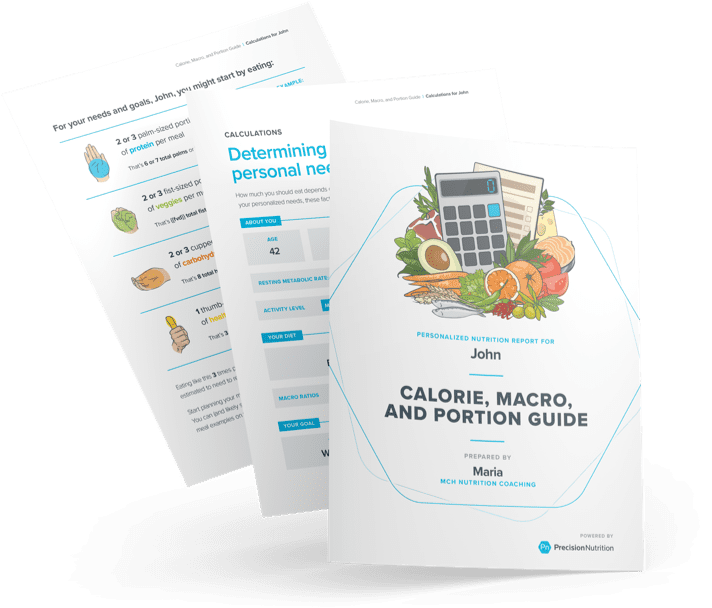
And after those are calculated, we’ll send you a free, personalized guide to using our hand portion system for hitting your calorie and macro targets.
Question #4: “Can I do hand portions with Paleo, keto, plant-based eating, and other diets?”
No matter the eating style, the answer is almost surely yes.
In fact, our hand portions calculator gives you the option of choosing from a variety of eating styles, including Mediterranean, Paleo, vegetarian, ketogenic, and fully plant-based. (If you’ll eat practically anything with no restrictions, there’s an option for that, too.)
What’s more, you can adjust your macronutrient split—that is, your relative proportions of protein, carbohydrates, and fats—before you get your results.
So if you’re not into keto (<10 percent carbs), but you prefer to eat lower-carb, you can adjust your hand portions to account for that. Same goes if you prefer a low-fat diet, or if you have any other preference about your macronutrient ratio.
The low-tech way to do this is to simply replace one portion for another. For instance, let’s say you prefer a low-fat diet, and you eat four meals a day. At two of your meals, you might nix the thumb of fats, instead adding an extra palm of protein, or an extra cupped handful of carbs. (You could also split the extra portion between the protein and carbs.)
The bottom line: The hand portions system is endlessly adaptable to a variety of eating styles, with almost no math required.
Question #5: “Do I gauge my portions before or after cooking?”
One of the most common questions asked about using your hands to measure portions is whether the hand portions are for cooked or uncooked foods.
The answer is both.
Hand portions are for plating your food, not cooking it. For foods you eat cooked, you gauge them once cooked (e.g., meat, pasta, rice). For foods you eat raw, you gauge them raw.
And if a food can be eaten both cooked or raw (such as spinach, for example) then you would use your hand to gauge the amount that is going onto your plate, whether you cooked it or not. (While there is a calorie difference between the cooked and uncooked version, that only really matters for folks with the most advanced aesthetic goals, such as bodybuilders).
That way, hand portions can be used anywhere: home, restaurants, buffets, conferences, at a friend’s house, the office.
Question #6: “How do I handle foods that don’t fit perfectly into a category?”
Most foods clearly fit into the hand portion categories: protein, carbohydrates, fat, and vegetables. (If you’re not sure about a certain food, this infographic will provide answers.)
But some foods and drinks don’t seem like they fit well into the hand-size portion system.
The good news: There are workarounds.
Most notably problematic are liquids and foods made from multiple ingredients (as opposed to whole foods).
Here’s how to handle them. And no, you don’t have to pour drinks into your cupped hand to measure them!
Dairy
Cow’s milk, non-Greek yogurt, and kefir are tricky as they’re a pretty even mix of protein, carbohydrates, and fat, or can vary depending on the fat level you choose (for instance, whole, low fat, skim).
We suggest making the decision of how to count a specific type of milk or yogurt based on the fat or carbohydrate content.
- Generally, consider 1 cup (8 ounces) of whole milk products a “thumb” of fat. (Yes, even though it’s larger than a thumb and also provides some protein and carbs.)
- Anything lower in fat (0 to 2 percent) is generally considered a cupped hand of carbs (while also providing some fats and protein).
- A cup of anything highly-sweetened (chocolate milk, strawberry yogurt) is generally considered a cupped hand of carbs (while also providing fats and protein).
So what happens in this situation: You have a full-fat yogurt or whole milk that’s highly sweetened? Is it a fat or carb?
Think of it this way: If it’s already full-fat, you know it’s a thumb of fat. But if a lot of sugar is also added to it, then it’s also a cupped hand of carbs.
The key here is to pick an approach, and apply it consistently. For most people, this is probably more important than the actual classification itself.
That’s because the hand portion system already has built-in buffers: It assumes your protein, fat, and carb sources contain smaller amounts of the other macros.
What’s more, if you’re consistent with how you gauge foods, you can more easily adjust based on the results you’re getting.
Plant milks
Plant milks are much like cow’s milk above. They tend to provide a mix of macros, depending on the source, and classification would also depend on whether or not they’re sweetened.
Generally, unsweetened versions (like plain almond milk) don’t count as anything, as they typically only have about 30 to 40 calories in a whole cup (8 ounces), and are often consumed in relatively small amounts.
A sweetened version, however, would be considered a cupped hand of carbs.
Again, the key is to pick an approach and follow it consistently.
Eggs
Eggs are considered a protein, but because they’re liquid in their raw form, people are sometimes unsure about how to measure them.
In general, two cooked whole eggs are the size of a palm. Four cooked egg whites are also the size of an average palm.
Of course, actual amounts may vary based on the size of your individual palm.
One question we’ve gotten about eggs: Why do two eggs count as a palm of protein when they only have about 6 grams of protein each? (So 12 grams of protein in total.)
It’s a good question. First, it’s important to remember:
With hand portions, we’re using our hands to gauge the portion size. We’re not reverse-engineering the portions based on how many macros are in a given food.
2 eggs are the size of an average palm, which is why they’re counted as one palm of protein.
If you’re wondering how this impacts your total protein intake, the answer goes back to the idea of assuming a mixed intake of a variety of different protein sources.
Overall, we estimate that each palm of protein is approximately 20 to 30 grams of protein. It’s true two eggs provide less protein than, say, a palm of chicken breast. But… a palm of chicken breast is actually above that 20- to 30-gram range.
The idea: Most sources—but not all—will land in that 20- to 30-gram range. And the average of all the different protein sources you eat will certainly end up in that range, even if there are some individual exceptions (like eggs and chicken breast).
Cookies, ice cream, chips (and other compound foods)
With naturally-occurring or minimally-processed foods, it’s usually best to assign only one hand portion to a food.
But with these highly-processed “compound” foods, you’ll want to assign two (or more) hand portions. Because just like dairy products that are full-fat and highly sweetened, they count as both fat and carbs.
Here’s an easy way to account for highly-processed and compound foods: one handful is equal to one thumb of fat and one cupped hand of carbs.
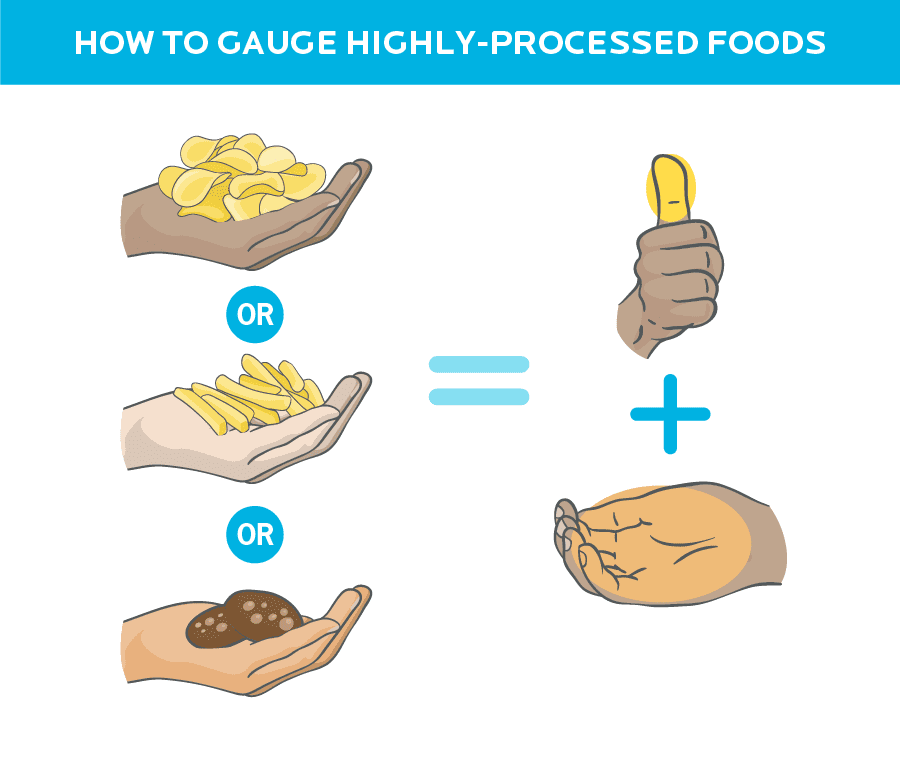
Soda and juice
Unfortunately, a serving of soda doesn’t really fit into a cupped hand. Regardless, consider a 12-ounce can of non-diet soda as one cupped hand of carbs.
Certainly, eight ounces would be preferable from the standpoint of physical size (and carbohydrate total), but 12 ounces really simplifies the process, as these beverages most often come pre-packaged this way.
(This is similar to how we account for bananas, apples, oranges, pears, and other fruits of different sizes, since they’re “pre-packaged” by nature.)
Again, the consistency of how you gauge your hand portions is actually the most important factor.
As for juice, consider an 8-ounce glass of juice to be one cupped hand of carbs.
Alcohol
In many ways, alcohol should be its own portion category, as the vast majority of its calories are derived from its alcohol content (7 kcal/gram), not its carb, protein or fat content.
This applies to pretty much all alcohol, be it light beer, microbrew/craft beer, wine, hard ciders, and spirits.
A “serving” of alcohol is about 5 ounces for wine, 1 ounce for spirits (example: vodka, whiskey, tequila), and 12 ounces for beer.
However, with the rise of craft beers, such as double IPAs that have much higher alcohol content than “regular” beer, the standard “beer serving” doesn’t hold up as well as it once did.
Most “regular” beer is about 4 to 5 percent alcohol by volume (ABV). Many craft beers can be as high as 9 percent ABV, some even reaching 15 to 20 percent ABV.
And since alcohol itself provides calories (again, 7 kcal/gram), doubling or tripling the alcohol content dramatically increases the calorie content.
Additionally, many craft beers have higher amounts of carbs than “regular” beers. The amount of carbs in a beer depends on how it’s made.
If the beer has a thicker mouthfeel, darker appearance, and sweeter flavor, it will most likely have more carbs. The amount of carbs in a 12 ounce “serving” of beer ranges from 2 to 16 grams. Plus, many craft beers come in 16 ounce sizes, or pints, which means they are 33 percent larger, and thus provide 33 percent more alcohol, carbs, and calories.
Is your head spinning yet? Don’t overcomplicate. Like we said, simpler is better.
So…
For hand portion purposes, we recommend counting them as follows:
- A serving of wine, spirits or “regular” beer counts as one cupped hand of carbs or 1 thumb of fat.
- A serving of dessert wine, sweetened spirit (e.g. gin and tonic, margarita), or sweeter/high-alcohol/craft beer counts as two portions—either 2 cupped hands of carbs, 2 thumbs of fat, or 1 of each.
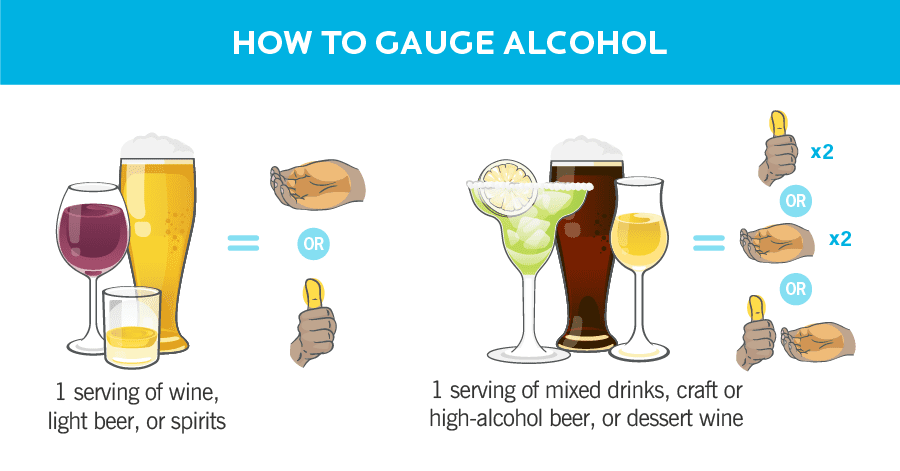
One last note on alcohol: While you can count your alcohol intake with hand portions, it is still important to be mindful of your overall number of drinks. (You can learn more here about how all drinking comes with potential health effects.)
Question #7: “How do I count portions for mixed-food meals?”
Dishes comprised of a big mix of foods, such as soups and stews, can make it tricky to assign hand portions (just as they make it difficult if you’re tracking macros or calories).
You simply have to eyeball it, and make your best guess, especially if you didn’t make the meal yourself.
Ultimately, the general goal is to get a portion of protein, veggies, quality carbs, and/or healthy fats in each serving. This is relatively easy to do when cooking for yourself. When eating meals made by others, simply guesstimate as well as you can.
Most importantly, if the goal is anything other than weight gain, eat slowly and mindfully, until satisfied.
Often, mixed-food meals like this are a combination of protein, carbs, and fats, but are a bit lower in veggies. Adding a vegetable on the side can be very helpful. And adding additional protein can also be helpful if the meal seems to have a greater proportion of carbs and fats (which they often do).
One thing to remember here: For meals you have often, “set it and forget it.” Meaning, establish how you’ll gauge the hand portions, and consistently follow that approach. That way, if you ever want to adjust your intake, you’ll know how to count the hand portions. (If you decide to eat half the usual amount of a soup, you’d then only count half the usual hand portions.)
Question #8: “Should I count legumes and lentils as protein or carbs?”
Legumes and lentils contain both protein and carbs, so where should they be counted?
Answer: It depends on the meal itself and/or the eating style of the individual.
If someone is fully plant-based/vegan, then it’s likely the legumes or lentils will count as their protein source, since those are probably the most protein-dense foods they’re consuming in a given meal.
For most other eaters, beans and legumes would generally count as a carb source, since they are far richer in carbs than protein.
But they can also count as both… under certain conditions.
Our suggestion: Choose the most protein-rich food (assuming there is one) as your protein source, and slot the other items from there.
Examples:
- Chicken with beans, broccoli and olive oil
- Beans with rice, broccoli and olive oil
- Two portions of beans with broccoli and olive oil
- One portion of beans with broccoli and olive oil
In example 1, chicken is the protein (the most protein-rich part of the dish), beans are the carbs, broccoli is the vegetable, and olive oil is the fat.
In example 2, beans are the protein (the most protein-rich part of the dish), rice is the carb, broccoli is the vegetable, and olive oil is the fat.
In example 3, one serving of beans would count as protein, and the other serving would count as carbs. In this scenario, it gets more difficult because it’s less clear-cut than the first two examples.
In example 4, it would depend on the eater. Omnivore? Then we’d likely count the beans as a carb. Plant-based? Then we’d likely count the beans as a protein.
Question #9: “What do I do when I’m not seeing results with hand portions?”
You can always consider tweaking your hand portions, but before you do that it can be helpful to understand realistic rates of progress.
Stick with a consistent number of hand portions for at least two weeks and monitor your progress before trying to switch things up. This allows enough time to determine whether you’re getting closer to your goal—or not.
If your goal is fat loss…
How fast you can lose body fat depends on how consistently you can, or want to, follow the guidelines you’re given.
Realistic rates of fat loss per week
| Progress | % Body Weight | Men | Women |
|---|---|---|---|
| Extreme | 1-1.5% body weight | ~2-3 lb (0.91-1.36 kg) | ~1.65-2.5 lb (0.75-1.13 kg) |
| Reasonable | 0.5-1% body weight | ~1-2 lb (0.45-0.91 kg) | ~0.8-1.65 lb (0.36-0.75 kg) |
| Comfortable | <0.5% body weight | ~<1 lb (0.45 kg) | ~<0.8 lb (0.36 kg) |
Here’s how to quantify each of these categories:
Extreme: Requires about 90 to 100 percent consistency.
Reasonable: Requires about 70 to 85 percent consistency.
Comfortable: Requires about 50 to 65 percent consistency.
Clearly, the more consistent you are, the faster your progress, and the more fat you may lose.
It’s also important to realize that fat loss is rarely linear. It fluctuates from day to day and week to week. The goal is to see an overall trend downward over time.
But if you’re not seeing that trend…
You can adjust your hand portions by removing 1 to 2 cupped handfuls of carbs and/or 1 to 2 thumbs of fats from your daily intake. (That’s 2 to 3 total portions of carbs and fats, combined.) This works out to eating about 250 calories less per day.
If your goal is muscle gain…
The ability to gain muscle is dependent on age, biological sex, genetics, and consistency with food intake, along with resistance training experience, intensity, frequency, style, volume, and more.
Realistic rates of muscle gain per month
| Fitness level | Men | Women | ||
|---|---|---|---|---|
| Beginner | 1-1.5% body weight |
~1.5-2.5 lb (0.68-1.13 kg) | 0.5-0.75% body weight |
~0.65-1 lb (0.29-0.45 kg) |
| Intermediate | 0.5-0.75% body weight |
~0.75-1.25 lb (0.34-0.56 kg) | 0.25-0.375% body weight |
~0.325-0.5 lb (0.14-0.23 kg) |
| Advanced | 0.25-0.375% body weight |
~0.375-0.625 lb (0.17-.28 kg) | 0.125-0.1875% body weight |
~0.1625-0.25 lb (0.07-0.11 kg) |
Much like fat loss, muscle gain is often not linear. Progress seems to come in fits and spurts, especially after the first year of dedicated training.
But if you’re not gaining muscle as expected…
Simply add 1 to 2 cupped handfuls of carbs and/or 1 to 2 thumbs of fats to your daily intake. (Again, that’s 2 to 3 total portions of carbs and fats, combined.) This works out to an increase of about 250 calories a day.
Want to learn more? Here’s a deep dive into how to adjust your portions when you’re not seeing progress, plus a nifty downloadable reference guide on how to tweak your intake to get better results.
Question #10: “How do I get skeptical clients on board with trying hand portions?”
If you’re a coach, you may have clients used to counting calories and/or macros, who don’t believe that hand portions could possibly deliver the same results.
On the other hand, you might have clients who don’t count anything, preferring a more intuitive method instead.
There’s nothing wrong with either of these approaches. (Here’s more info on how hand portions, macro counting, calorie counting and intuitive eating compare.)
But when a client isn’t seeing the results they’re looking for with their current food intake tracking method, you might have a hunch that hand portions could help.
So how do you help hand-portion skeptics?
Treat using hand portions as an experiment.
Self-experimentation is one of the cornerstones of our very own coaching program. (Learn more: 3 diet experiments that can change your eating habits.)
Why? It takes away the pressure to make a “perfect” nutrition choice. If you experiment with something and it doesn’t work out—no big deal. You’re one step closer to figuring out what works for you by process of elimination.
And best case scenario? You find something that really does work for you.
So if your client is willing to try out hand portions for two weeks, make it an experiment.
Encourage them to gather their data about the experience like a scientist, without judgement.
At the end of the two weeks, check in to see how the experiment went, and decide how you’ll move forward together.
We find that hand portions work for many (if not most!) of our clients once they try them. But be open to the idea that your client may still feel uncertain about hand portions after their experiment is done. That’s okay.
Every person is different, and you never know exactly how a particular way of eating is going to work until you try.
Bonus question: “Okay, but are there times when hand portions aren’t appropriate?”
People who want to eat, move, and live better usually do well with hand portions. They’re convenient, easy to understand, and highly customizable with very little effort involved.
But it’d be wrong to say that hand portions are hands-down the best approach for everyone.
Different strategies work for different types of goals. Ultimately, whether you choose to use hand portions, PN’s plate method, macro counting, nutrient timing protocols, or any other nutritional tool depends on what you hope to achieve, or the “job to be done.”
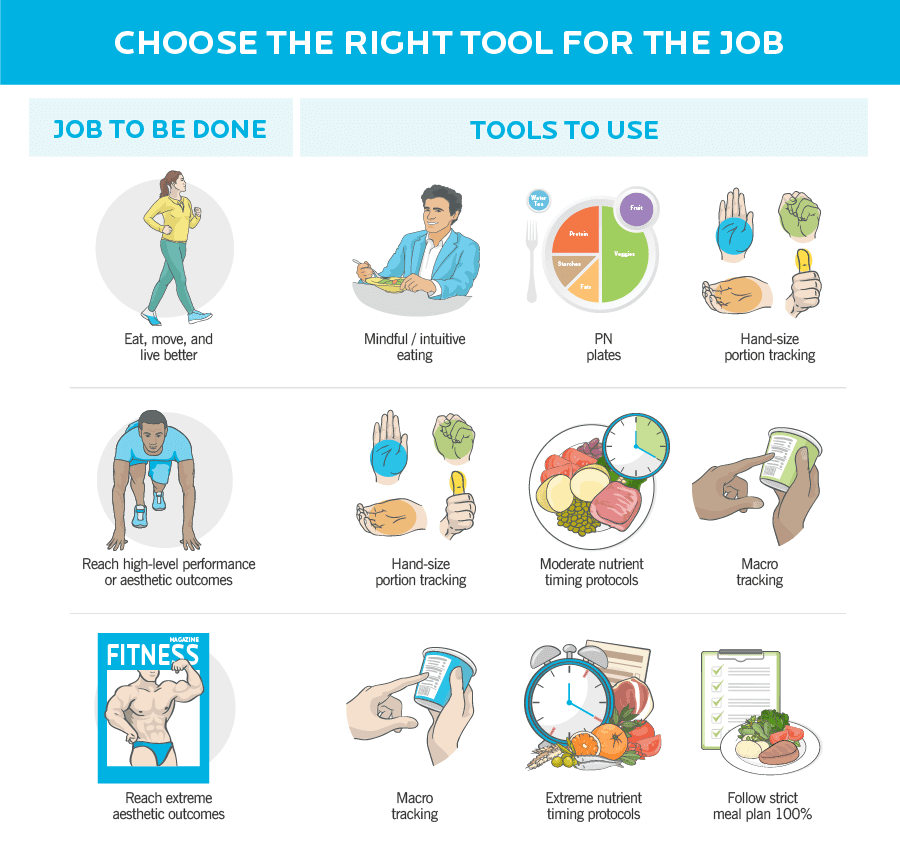
In particular, hand portions may not be the right approach for people who have the most aggressive aesthetic and performance goals.
For instance, professional athletes and physique models may need a more precise strategy, such as macro counting or even a strict meal plan. It’s the same with athletes who need to cut weight or reach a specific body fat percentage—such as in preparation for a UFC fight.
Keep in mind: These people are essentially being paid to eat this way. It’s part of their job. And that comes with tradeoffs.
(If you’re wondering what those tradeoffs might look like, check out our resource on the cost of getting lean.)
There will also be some people who try hand portions and simply don’t like them.
For example, people who love numbers and data might find tracking macros and calories along with body changes empowering. These folks are also usually emotionally detached from the numbers—seeing them as information rather than assigning them “good” or “bad” values.
These people might experiment with hand portions, as described above, and say, “Nah, I’m good.” That’s valid.
It really comes down to this:
Hand portions work for a lot of—if not most—people. But there are always exceptions, because there’s no single best way to eat.
References
Click here to view the information sources referenced in this article.
If you’re a coach, or you want to be…
You can help people build sustainable nutrition and lifestyle habits that will significantly improve their physical and mental health—while you make a great living doing what you love. We'll show you how.
If you’d like to learn more, consider the PN Level 1 Nutrition Coaching Certification. (You can enroll now at a big discount.)


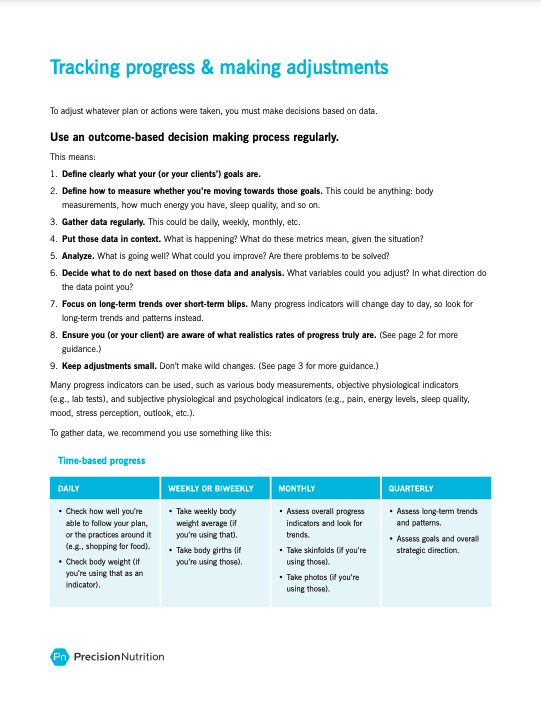

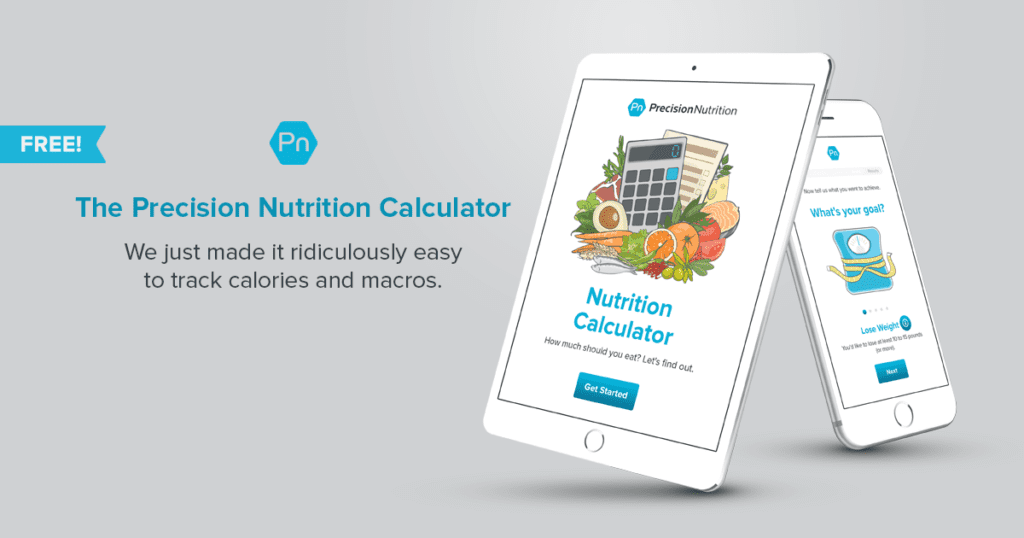

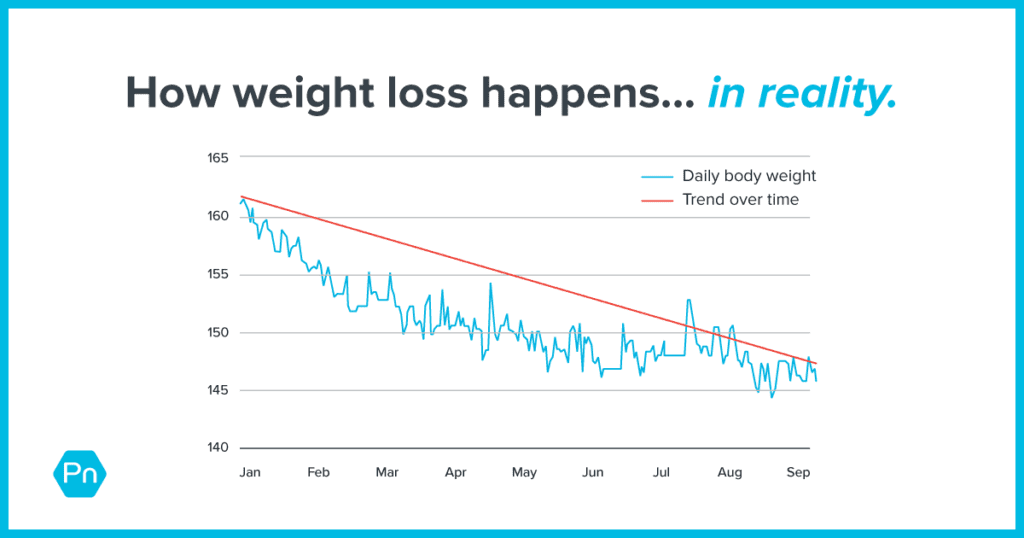
Share